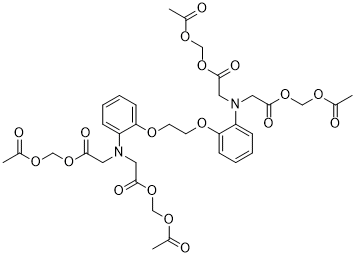All AbMole products are for research use only, cannot be used for human consumption.

BAPTA-AM exerts an open channel blocking effect on hERG, hKv1.3 and hKv1.5 channels with IC50 of 1.3, 1.45 and 1.23 μM in HEK 293 cells. BAPTA-AM, as an intracellular calcium chelator, induces delayed necrosis by lipoxygenase-mediated free radicals in mouse cortical cultures. BAPTA-AM prevents free radical-mediated toxicity promote apoptosis in non-neuronal cells and produce a beneficial effect in neuronal cells by protecting neurons from ischemic damage. In addition, it has been suggested that BAPTA-AM induces a late, but not early, increase of intracellular calcium in I-IL-60 neoplastic cells. Mixed cortical cell cultures (DIV 13-16) exposed to 10 μM BAPTA-AM for 24- or 48-hr show moderate (45-70%) neuronal injury as evaluated by increased LDH release into the bathing medium after 24-48-hr.

FASEB J. 2025 Jan 31;39(2):e70354.
In vitro stretch modulates mitochondrial dynamics and energy metabolism to induce smooth muscle differentiation in mesenchymal stem cells
BAPTA-AM purchased from AbMole

Cell Prolif. 2023 Apr;56(4):e13385.
Functional cooperation between IKCa and TRPC1 channels regulates serum-induced vascular smooth muscle cell proliferation via mediating Ca2+ influx and ERK1/2 activation
BAPTA-AM purchased from AbMole

Neurochem Res. 2023 Feb;48(2):447-457.
Ca2+ Regulates Autophagy Through CaMKKβ/AMPK/mTOR Signaling Pathway in Mechanical Spinal cord Injury: An in vitro Study
BAPTA-AM purchased from AbMole

Environ Pollut. 2021 Feb 1;270:116051.
Bisphenol AF induces apoptosis via estrogen receptor beta (ERβ) and ROS-ASK1-JNK MAPK pathway in human granulosa cell line KGN
BAPTA-AM purchased from AbMole

Ecotoxicol Environ Saf. 2021 Sep 1;220:112341.
Cadmium induces apoptosis of human granulosa cell line KGN via mitochondrial dysfunction-mediated pathways
BAPTA-AM purchased from AbMole

Arab J Chem. 2021 Nov;14(11):103399.
Bisphenol A and bisphenol AF co-exposure induces apoptosis in human granulosa cell line KGN through intracellular stress-dependent mechanisms
BAPTA-AM purchased from AbMole

Ecotoxicol Environ Saf. 2021 Jan 15;208:111429.
Bisphenol A induces apoptosis through GPER-dependent activation of the ROS/Ca 2+-ASK1-JNK pathway in human granulosa cell line KGN
BAPTA-AM purchased from AbMole
| Molecular Weight | 764.68 |
| Formula | C34H40N2O18 |
| CAS Number | 126150-97-8 |
| Solubility (25°C) | DMSO 40 mg/mL |
| Storage |
Powder -20°C 3 years ; 4°C 2 years In solvent -80°C 6 months ; -20°C 1 month |
| Related Potassium Channel Products |
|---|
| Palmitoyl-L-carnitine chloride
Palmitoyl-L-carnitine chloride (L-Palmitoylcarnitine chloride) is a long-chain acylcarnitine and a fatty acid metabolite, accumulates in the sarcolemma and deranges the membrane lipid environment during ischaemia. Palmitoyl-L-carnitine chloride inhibits KATP channel activity, without affecting the single channel conductance, through interaction with Kir6.2. |
| VU0810464
VU0810464 is a potent and selective non-ureaG protein-gated inwardly-rectifying potassium channels (GIRK, Kir3) activator. VU0810464 displays nanomolar potency for neuronal (EC50=165 nM) and GIRK1/4 (EC50=720 nM) channels with improved brain penetration. |
| QO 58
QO 58 is a potent modulator of K(v)7 channels. |
| NS3623
NS3623 is an activator of human ether-a-go-go-related gene (hERG1/KV11.1) potassium channels. |
| ML67-33
ML67-33 is a selective activator of temperature- and mechano-sensitive K2P channels. |
All AbMole products are for research use only, cannot be used for human consumption or veterinary use. We do not provide products or services to individuals. Please comply with the intended use and do not use AbMole products for any other purpose.


Products are for research use only. Not for human use. We do not sell to patients.
© Copyright 2010-2024 AbMole BioScience. All Rights Reserved.
